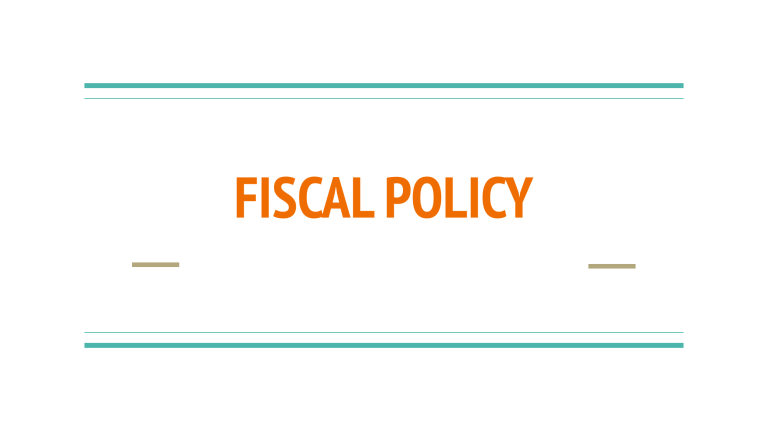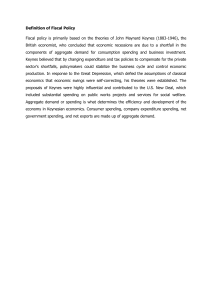
FISCAL POLICY Demand side policies ● Deflationary gap: The amount by which actual aggregate demand falls short of aggregate supply at the level of full employment (i.e., the gap between Y1 and YF shown below). Demand side policies ● Inflationary gap: The amount by which actual aggregate demand exceeds aggregate supply at the level of full employment (i.e., the gap between Y1 and YF shown below). TWO TYPES OF DEMAND-SIDE POLICIES ● Monetary policy: ● The process by which the monetary authority of a country, like the central bank, controls the supply of money, often targeting an inflation rate or interest rate to ensure price stability. ● Fiscal policy: ● The use of government revenue collection (mainly taxes) and expenditure (spending) to influence the level of economic activity. FISCAL POLICY ● A government budget is ● an annual financial statement presenting the government's proposed revenues and spending for a financial year that is often passed by the legislature, approved by the chief executive or president and presented by the Finance Minister to the nation. GOVERNMENT REVENUE ● The main sources of government revenue are as follows: ● Direct and indirect taxes. ● Direct (e.g., income and company taxes) and indirect (e.g., sales, VAT, and excise taxes) taxes are typically the largest source of government revenue. ● Sales of goods and services ● from state-owned enterprises (e.g., postal services and vehicle licensing) and the fees charged by other government departments (e.g., issuing building consents and passports). ● The revenue earned from the sale of goods and services varies by country. For example, in Saudi Arabia, the state-owned petroleum company generates over US$200 billion annually. ● The sale of state-owned (government-owned) enterprises, the sale of which generates a one-off payment to the government. ● Such sales are termed privatisation and are a transfer of ownership from the government to the new private sector owners. BUDGET SURPLUSES AND DEFICITS ● Over time, the accumulation of government budget deficits leads to government debt. ● If governments do not have a source of savings such as accumulated surpluses, then governments will need to finance deficits by borrowing money by issuing bonds or other such securities. GOVERNMENT EXPENDITURE ● Current expenditures. is expenditure on goods and services consumed within the current year, such as health and educational services. ● Examples would include the wages and salaries of police officers, nurses and teachers. ● Also included in current expenditures are any interest payments on outstanding government loans and the provision of subsidies to industry. GOVERNMENT EXPENDITURE ● Capital expenditures. This is money spent by the government on acquiring or maintaining fixed assets, such as land, buildings, and equipment. ● Money will be spent on producing physical capital such as roading, harbours and airports, as well as the building of hospitals and schools. GOVERNMENT EXPENDITURE ● Transfer payments. ● Transfer payments include payments by the government to vulnerable groups for the purposes of income redistribution (for example, unemployment benefits, child allowances, pension etc.). ● These are frequently used to redistribute income from high income earners to those who need income support such as the unemployed, sick, disabled and elderly. GOVERNMENT EXPENDITURE ● Both current and capital expenditure appear in GDP calculations as government spending (“G” in the expenditure approach), whereas transfer payments do not as they do not represent the output of goods and services being produced. The goals of fiscal policy Low and stable inflation Low unemployment Promote a stable economic environment for long-term growth Reduce business cycle fluctuations Equitable distribution of income External balance EXPANSIONARY FISCAL POLICY ● Expansionary fiscal policy ● occurs when government taxation and expenditure is adjusted in the form of tax cuts, increased transfer payments and increased government spending. ● Expansionary fiscal policy can take one or any combination of the following forms: ● Increased government spending (i.e., increased transfer payments or infrastructure spending; ↑AD = C + I + ↑G + (X – M). ● Decreases in the rates of personal income taxes. For example, decreasing the rate of personal income tax from 35% to 25% will increase the disposable income of households and increase consumer expenditure ↑AD = ↑C + I + G + (X – M). ● Decreases in the rate of business taxes which, ceteris paribus, will lead to an increase in profitability and an increase in business investment ↑AD = C + ↑I + G + (X – M) ● If a government runs an expansionary fiscal policy by increasing transfer payments to households, reducing personal and business income taxes, etc. ● then real disposable incomes for consumers and firms will increase. ● With increased incomes comes increased demand for goods and services and AD will increase. ● And, as AD increases, firms will employ more resources to meet the increased demand for their goods and services ● – unemployment in the economy falls as the economy moves to achieving the full employment level of output – YF. CONTRACTIONARY FISCAL POLICY ● Decreased government spending ● Increases in the rates of income taxes ● Increases in the rate of business taxes ↓AD = ↓C + ↓I + ↓G + (X – M). CONTRACTIONARY FISCAL POLICY ● A decrease in AD caused by contractionary fiscal policy when the economy is operating at the full employment level of output (YF) will maintain price stability without a decrease in real output (real GDP). ● When the level of economic activity is near or below the full employment level of output (YF), then contractionary fiscal policy will not be appropriate. ● A decrease in aggregate demand caused by contractionary fiscal policy at this stage will reduce economic growth and increase unemployment and cause a deflationary output gap. Does fiscal policy work? Video HW Activity 1,2,3 EVALUATING FISCAL POLICY (Limitations) ● Time lags. There are a number of time delays until: ● • the problem (recessionary or inflationary gap) is recognised by the government authorities and economists ● • the appropriate policy to deal with the problem is decided upon ● • the policy takes effect in the economy. By the time the policy action has taken effect the problem may have become less or severe, so that the policy action is no longer the most appropriate one. EVALUATING FISCAL POLICY (Limitations) ● Political constraints ● Government spending and taxation face numerous political pressures. ● Spending for social services (merit goods) and public goods cannot easily be cut if a contractionary policy is required. ● On the other hand, tax increases are politically unpopular and may be avoided by the government even though they might be necessary. EVALUATING FISCAL POLICY (Limitations) ● In a recession, tax cuts may not be very effective in increasing aggregate demand ● Tax cuts are less effective in a recession than increases in government spending because part of the increase in after tax income is saved. ● If the proportion of income saved rises due to pessimism about the future, the impacts of tax cuts on aggregate demand are even weaker. ● Increases in government spending are more powerful because they work in their entirety to increase aggregate demand. EVALUATING FISCAL POLICY (Limitations) ● May be inflationary. If it lasts too long it may be inflationary, this may occur if aggregate demand increases beyond what is necessary to eliminate a deflationary/recessionary gap. EVALUATING FISCAL POLICY (Limitations) Crowding out (HL only) If the government pursues an expansionary fiscal policy involving spending increases without an increase in revenues, it is forced to borrow. Government borrowing involves an increase in the demand for money, which leads to an increase in the rate of interest. A higher interest rate in turn can lead to lower investment spending by private firms, or a ‘crowding out' of private investment. This means that the government’s expansionary fiscal policy is weakened, since a greater G (government spending) is counteracted by a lower / (investment spending). Diagram. Advantages of Fiscal policy (p. 403) Advantages of Fiscal policy ● Automatic stabilisers (HL only) are factors that automatically, without any action by government, work toward stabilising the economy by reducing short term fluctuations of the business cycle. ● There are two important stabilisers: progressive income taxes and unemployment benefits. AUTOMATIC STABILISERS ● Progressive income taxes. Income taxes are progressive when the fraction of income that is taxed increases as income increases. ● In the upswing of the business cycle, as real GDP and incomes rise, income taxes rise proportionately more than the rise in income, causing after-tax (disposable) income to be lower than it would otherwise be. ● This means aggregate demand increases less, and this counteracts the economic expansion, making it smaller than it would otherwise be. ● Unemployment benefits. In a recession, as real GDP falls and unemployment increases, unemployment benefits rise. ● If there were no unemployment benefits, unemployed workers’ spending would fall significantly, putting a strong downward pressure on consumption spending and aggregate demand. ● The presence of unemployment benefits means that as workers become unemployed, their consumption will be maintained to some extent as their benefits partially replace their lost income, thus lessening the downward pressure on aggregate demand. Note: Automatic stabilizers cannot by themselves stabilise the economy and eliminate inflationary and recessionary gaps on their own. They can only help make economic fluctuations milder. FISCAL POLICY AND CROWDING OUT ● https://www.youtube.com/watch?v=HRYaXktH_O4 REAL WORLD VS THEORY examples (Paper 1) 1 On Dec. 21, 2020, the U.S. Congress passed a $900 billion stimulus and relief bill attached to the main omnibus budget bill. The president signed the bill on Dec. 27, 2020, but urged Congress to increase the direct stimulus payments from $600 to $2,000. 2.https://www.piie.com/blogs/realtime-economic-issues-watch/britains-c ontractionary-fiscal-stimulus 3. Book has examples 4. Inthinking example EDIT FISCAL POLICY AND Long run GROWTH (act. 5) ● Fiscal policy can be used to promote long-term economic growth (increases in potential output) ● indirectly by creating an economic environment that is favourable to private investment, ● and directly through government spending on physical capital goods and human capital formation, as well as the provision of incentives for firms to invest. ● Although fiscal policy is essentially focussed on the short-term stabilisation of economic activity, it can also promote long-term economic growth INDIRECT EFFECTS ON LRAS ● A stable economic environment with low and stable rates of inflation and consistent economic growth without large or frequent swings in economic activity (the business cycle) ● enables both consumers and businesses to plan and perform economic activities such as producing, investing, consuming and saving. ● Investment in capital goods by firms and the development and adoption of new technology is the key to increasing the potential output of an economy. DIRECT EFFECTS ON LRAS ● Directing government spending to the development and maintenance of physical capital goods. ● For example, infrastructure spending by government on road and rail networks, airports and ports, telecommunications (e.g., fast internet speeds) ● Government spending can be directed into research and development (R&D) initiatives in state-owned enterprises, universities and private firms in the aim to improve technological developments. DIRECT EFFECTS ON LRAS ● Government spending can be directed towards improving human capital. ● Increased spending on preschool, school, university and training establishments will lead to an increase in the productivity of labour. ● Governments can increase investment spending by firms by lowering corporate tax rates and/or providing tax incentives for firms to engage in research and development activities. ● Increased investment will lead to an increase in an economy’s potential output (YF).




